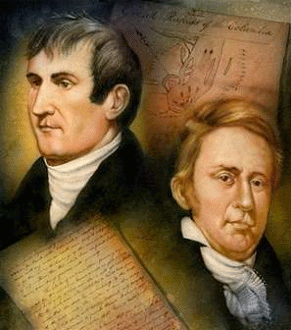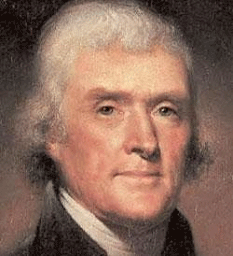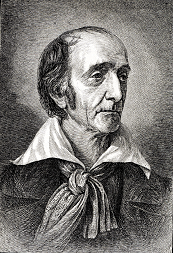|
Partner Highlight - NOAA's National Geodetic Survey (NGS)
 |
National Oceanic and
Atmospheric Administration |
To honor Lewis and Clark's contributions to mapping, NOAA's National Geodetic Survey (NGS) is installing a series of commemorative markers along the route that Lewis and Clark traveled. The marks begin at Thomas Jefferson's home in Monticello Virginia, continue westward to Lewis and Clark's winter home on the Pacific Ocean, Fort Clatsop in Oregon, and then loop back eastward ending under the Arch of St. Louis. NGS is positioning these markers using the satellite-based Global Positioning System. These markers will be incorporated into the National Spatial Reference System NSRS, the federal standard and foundation for all positioning and navigation activities in the United States.
 |
| Department of Commerce |
In May 1804, as Lewis and Clark were about to move west along the Missouri River, President Thomas Jefferson wrote, "We shall delineate with correctness the great arteries of this great country: those who come after us will fill up the canvas we begin." While Jefferson directed Lewis and Clark to gather information about the people, animals, and plants of the West, one of his main objectives was to chart the territory, hoping to find a waterway to the Pacific Ocean. In his instructions to Meriwether Lewis, Jefferson writes, "Beginning at the mouth of the Missouri, you will take observations of latitude and longitude at all remarkable points on the river, & especially at the mouths of rivers, at rapids, at islands & other places & objects distinguished by such natural marks & characters of a durable kind, as that they may with certainty be recognized hereafter."
 |
| Lewis and Clark |
Even before becoming president in 1801, Jefferson had dreamed of probing the uncharted West for many years. He was involved in several expeditions sent to find a water passage to the west coast of North America, but they were unsuccessful. Yet, these attempts gave Jefferson experience in exploration, providing a basis for his future pursuits of mapping unknown land. Jefferson's presidency gave him the necessary resources to seriously consider exploration of the West. In his first inaugural address, he saw "A rising nation, spread over a wide and fruitful land, advancing rapidly to destinies beyond the reach of mortal eye." Less than two years later, on January 18, 1803, Jefferson followed through with his vision, requesting $2,500 from Congress for the Corps of Discovery, which became known as the Lewis and Clark expedition.
After the success of the Corps of Discovery expedition, Jefferson desired to survey the Eastern coast of America in an effort to reduce the number of shipwrecks that commonly occurred due to the lack of accurate charts. With a clear delineation of the coastline, many products and ships could be saved, expanding commerce and industry. An act was passed by Congress on February 10, 1807, authorizing Jefferson to establish an organization to survey the coasts of the United States.
 | "Be it enacted by the Senate and the House of Representatives of the United States of America in Congress assembled, That the President of the United States shall be, and he is hereby authorized and requested, to cause a survey to be taken of the coasts of the United States, in which shall be designated the islands and shoals, with the roads or places of anchorage, within twenty leagues of any part of the shores of the United States; and also the respective courses and distances between the principal capes, or head lands, together with such other matters as he may deem proper for completing an accurate chart of every part of the coasts within the extent aforesaid."
|
| Thomas Jefferson |
 |
| Ferdinand Hassler |
Ferdinand Hassler
After analyzing the ideas of several surveyors, Jefferson chose Swiss-born Ferdinand Hassler to become the Superintendent of the new bureau, called the Survey of the Coast. In 1878, the agency was reorganized and given a new name, the Coast and Geodetic Survey (C&GS;), which it maintained until 1970. The name C&GS; acknowledged the importance of geodesy, the science concerned with measuring the size and shape of the earth. In 1970, a reorganization created the National Oceanic and Atmospheric Administration (NOAA), and the National Ocean Service (NOS) was created as a line office of NOAA. Part of C&GS; became the National Geodetic Survey (NGS) and was located within NOS.
The mission of NOAA's National Geodetic Survey (NGS) is to ensure that the United States has a consistent, high-accuracy geodetic reference foundation that supports a multitude of needs. The safety and efficiency of the buildings we live in and work in, the roads and bridges we drive on, and the trains, airplanes, and ships that carry the products we use everyday, all depend on a universally compatible system of geodetic reference points that tie our nation together.
Today, NOAA conducts research and gathers data about the global oceans, atmosphere, space, and sun, and applies this knowledge to science and service that touch the lives of all Americans. NOAA warns of dangerous weather, charts our seas and skies, guides our use and protection of ocean and coastal resources, and conducts research to improve our understanding and stewardship of the environment which sustains us all.
NOAA is located within the US Department of Commerce and provides these services through its five line offices: the National Ocean Service (NOS), the National Weather Service (NWS), the National Marine Fisheries Service (NMFS), the National Environmental Satellite, Data and Information Service(NESDIS), and NOAA Research. In addition, NOAA research and operational activities are supported by the Nation's seventh uniformed service, the NOAA Corps, a commissioned officer corps of men and women who operate NOAA ships and aircraft, and serve in scientific and administrative posts.
NOS:
NOAA's National Ocean Service (NOS) has created a challenging vision for its future as the Global Leader in Integrated Management of the Ocean (GLIMO). The vision provides a focus for the agency to apply its diverse resources to address the growing pressures impacting coastal and ocean resources.
NOS is a scientific and technical organization of more than 1,700 individuals whose mission is to preserve and enhance the nation's coastal resources and ecosystems along 95,000 miles of shoreline and 3.5 million square miles of coastal ocean. At the same time, it works to support economic growth for the long-term benefit of the nation. This theme is central to the sustainable development agenda of both NOAA and DOC.
NOS employees are located at duty stations around the country. Most of them are at headquarters in Silver Spring, Md., and in regional offices in Seattle, Norfolk, Va., and Charleston, South Carolina. This nationwide presence is complemented and enhanced by the numerous partnerships with states, local governments, academic institutions, and non-governmental organizations that receive NOS technical and financial assistance.
NWS:
The National Oceanic and Atmospheric Administration's (NOAA) National Weather Service (NWS) serves America every day. The NWS is the sole United States official voice for issuing warnings during life-threatening weather situations and provides weather, water, and climate forecasts and warnings for the United States, its territories, adjacent waters and ocean areas, to protect life and property and enhance the national economy. Weather services cost each American about $5 a year- roughly the cost of a fast food meal. This investment allows the NWS to issue climate, public, aviation, marine, fire, weather, river and flood forecasts and warnings every day.
The NWS has about 4,700 employees in 122 weather forecast offices, 13 river forecast centers, 9 national centers and other support offices around country; with an annual operating budget of approximately $700 million in 2003 supporting a national infrastructure to gather and process data worldwide from the land, sea and air. The infrastructure includes collecting data from familiar technologies such as Doppler weather radars, satellites operated by NOAA's National Environmental Satellite, Data, and Information Service (NESDIS), and also less-familiar technologies such as data buoys for marine observations and surface observing systems. The highly trained and skilled NWS workforce maintains and uses sophisticated computer models running on high speed supercomputers; powerful workstations to analyze weather, radar, satellite and other data; and high-speed communications systems to gather and distribute this information. NWS staff also use trained community volunteers to enhance weather service operations. Cooperative observers collect weather data that become part of the nation's climate records and citizen storm spotters provide the NWS with visual confirmation of severe weather events.
 |
NMFS:
NOAA's National Marine Fisheries Service (NMFS) is responsible for the management, conservation and protection of living marine resources within the United States Exclusive Economic Zone. NOAA Fisheries also plays a supportive and advisory role in the management of living marine resources in coastal areas under state jurisdiction, provides scientific and policy leadership in the international arena and implements international conservation and management measures as appropriate.
Under this mission, the goal is to optimize the benefits of living marine resources to the Nation through sound science and management. This requires a balancing of multiple public needs and interests in the sustainable benefits and use of living marine resources, without compromising the long-term biological integrity of coastal and marine ecosystems.
NESDIS:
The National Environmental Satellite, Data and Information Service (NESDIS) operates the satellites and manages the processing and distribution of millions of bits of data and images these satellites produce daily. The prime customer for the satellite data is the NOAA National Weather Service, which uses satellite data to create forecasts for television, radio, and weather advisory services.
NOAA's operational environmental satellite system is composed of: geostationary operational environmental satellites (GOES) for short-range warning and "nowcasting," and polar-orbiting environmental satellites (POES) for longer term forecasting. Both kinds of satellites are necessary for providing a complete global weather monitoring system. The satellites carry search and rescue instruments, and have helped save the lives of about 10,000 people to date. The satellites are also used to support aviation safety (volcanic ash detection), and maritime/shipping safety (ice monitoring and prediction).
NOAA Research:
As the primary research and development organization within NOAA, the NOAA Office of Oceanic and Atmospheric Research (OAR) explores the Earth and atmosphere from the very surface of the sun to the depths of the ocean. Our role within NOAA is to provide products and services that describe and predict changes in the environment. NOAA Research results allow decision makers to make effective judgments in order to prevent the loss of human life and conserve and manage natural resources. We conduct research in three major areas: atmosphere, climate, and ocean and coastal resources.
Our responsibility is to address better management and understanding of the environment through research. NOAA Research explores the facets and trends of our environment that influence our future. Our research plays a key role in facing the new challenges of a rapidly changing society and our natural surroundings.
The personnel of NOAA and its individual line offices have served in peace and war; worked in the remote and frontier regions of our Nation; and experienced rough seas, violent weather, various and sundry hardships in accomplishing their mission. But through all of this they persevered with quiet courage and a fierce loyalty to their organization and the Nation.

|

